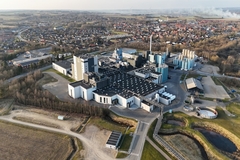
- Industry news
Industry news
- Category news
Category news
- Reports
- Key trends
- Multimedia
Multimedia
- Journal
- Events
- Suppliers
- Home
- Industry news
Industry news
- Category news
Category news
- Reports
- Key trends
- Multimedia
Multimedia
- Events
- Suppliers
Epi Ingredients unveils So Candy yogurt powder concept for confectionery and sweet sectors

02 Dec 2021 --- Epi Ingredients is spotlighting its So Candy concept using yogurt powder for confectionery and sweet treats, exclusively at Fi Europe (FiE), in Frankfurt. Mathieu Lucot, marketing manager at Epi discusses the confectionery applications and future plans with NutritionInsight.
“The So Candy concept is not a product but an application in confectionery, which suffers from a bad image because of high sugar. Consumers still want to eat candy but they also want it to be healthier.”
Aiming to showcase how products offered can be adapted to consumers’ wants, the France-based dairy ingredients supplier is exhibiting jelly candies in two flavors containing Yogurt Powder 48, wafer filings, as well as marshmallow with a chocolate shell, made with Yoghurt Powder 48 (black chocolate) and Kefir Powder (ruby chocolate).

“It is of course something that has a healthy image and a good taste as yogurt can be very appealing in candies. The natural acidity that is found in yogurt, and the freshness in the candy combined is very nice,” Lucot underscores.
To date, there has been a significant amount of interest from manufacturers, which Lucot notes does not necessarily have to be from confectionery producers but even food industries such as pizza.Mathieu Lucot, marketing manager at Epi Ingredients.
Nutrition demands drive up innovation
The yogurt cultures do not stay alive in the candy but scientific studies show that if live bacteria are present in the beginning of the process, the positive effects can still be felt even if the bacteria is dead in the finished product, Lucot highlights.
The company has also developed fermented dairy powders such as skyr and kefir, which are part of the company’s Epilac range.
Consumers are seeking natural products with intrinsic health benefits. This demand, amplified by the COVID-19 health crisis, creates a space for dairy products with a beneficial effect on digestive, immune and mental health, with ingredients rich in proteins and lactic ferments, says Epi Ingredients.
The fermentation process adds beneficial bacteria and enhanced micronutrients to foods for better nutritional quality, the company supports.
By focusing on first making yogurt and then drying it, allows it to differentiate from the more acidic milk powder. The final product is easy to implement and can be incorporated into a wide selection of food matrices. This enables it to have strong but pleasant dairy flavors and natural acidity to the finished product.
Controlling fermentation also gives the ability to obtain active or inactive flora, says Epi Ingredients.
Regulations impacting trends
Currently, kefir and skyr are “trendy” products available across supermarkets, Lucot states, adding how theese developments are “largely linked to limited regulation over yogurt claims.”
“In order to put a yogurt claim on a finished product actually depends on which country you commercialize the product.”
For example, France requires two strains and a high content of live strains in the finished product to be classified as a yogurt; otherwise, it will be a dairy dessert. Germany on the other hand, can class an item as a yogurt even if the bacteria is dead.
“Some manufacturers in Germany are producing milk powder which is skimmed milk powder with lactic acid or citric acid and call it a yogurt,” Lucot states.
Epi Ingredients’ choice to make the yogurt first and then dry it makes it far more costly but at the same time of superior quality, he notes.The company showcased how its yogurt powder could make confectionery healthier.
Honing in on alternative dairy
Currently, the company has no plans to develop plant-based ingredients, but it can imagine future concepts combining two sources of protein.
“There are nutritional benefits to both and there is scientific proof of that. We have to co-exist and the two are complementary, we do not need to be in opposition,” Lucot flags.
Though he notes the market for plant-based continues to flourish, there is a future for both plant-based and dairy-based sources.
Epi Ingredients launched its first-ever protein concentrate Epiprot 60 UL a few years ago in response to growing consumer demand for protein offerings that meet their expectations in terms of sustainability, transparency and animal welfare.
Meanwhile, earlier this week, FrieslandCampina Ingredients announced it was moving into the plant-based protein arena with two new powder solutions developed with AGT Foods.
By Andria Kades with additional reporting from Missy Green from FiE and HiE in Frankfurt










